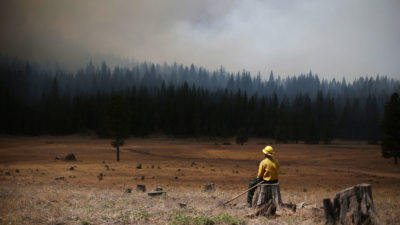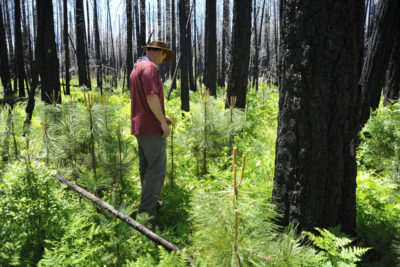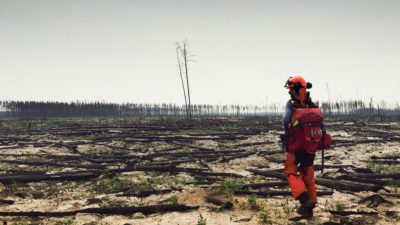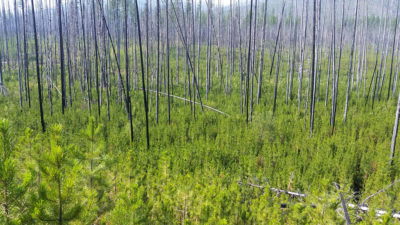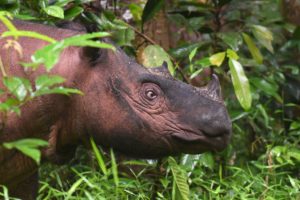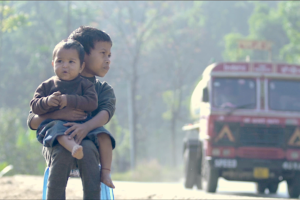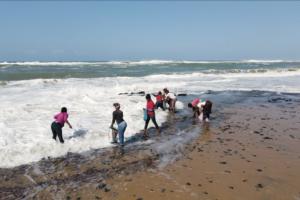在优胜美地国家公园以南的一英里处,消防生态学家查德·汉森(Chad Hanson大灰猫头鹰他今年春天早些时候发现了巢。这些稀有的鸟类在北美西部的堂兄上与堂兄不同,高2英尺,翼展约为5英尺。它们几乎可以在任何时候都可以看到,因为与大多数猫头鹰不同,它们白天和黑夜都活跃。
但是,在加利福尼亚的森林中只有200至300名成年人,这些成年人被干旱,昆虫,温度升高和火灾袭击。在近五年中,汉森 - 主要生态学家John Muir Project,一个致力于联邦森林的生态管理的非营利组织 - 一直在内华达山脉进行研究,他尚未看到成年的灰猫头鹰。它们几乎和居住在地区的斑点猫头鹰一样罕见。
As Hanson and I move into the site of the 2013Rim Fire,在该地区烧毁了400英里的创纪录的广场,我们在障碍物中发现了一只灰色的猫头鹰 - 一棵裸露的火片。汉森很兴高采烈,并不是有机会终于在斯坦尼斯劳斯看到这个物种的成年人,但是因为它使他对这场火灾的观点驱使回家:尽管遭受了广泛的破坏,所以森林生态系统正在自身反弹,没有联邦森林人的帮助,他们在大火发起了在其他地区进行伐木和重新种植计划。在我们的徒步旅行中,我们经过了一英亩的幼树和灌木,绿化了这个所谓的障碍林的曾经围起来的景观。
California’s Rim Fire “nuked” much of the landscape, necessitating a program of logging and replanting, according to one scientist.
汉森说:“自从轮辋大火燃烧以来,我们一直在稳定的人们坚持认为这是加利福尼亚历史上最灾难性和毁灭性的大火之一。”“他们声称什么都不会恢复,猫头鹰和鹿种群无法维持。他们和其他人以此为借口加速了障碍森林的清晰切割。”
在长期以来,关于如何最好地帮助森林在大火后再生的辩论中,篮筐大火已成为最新的阵线,随着气候变化的提高温度并导致干旱恶化,这在美国西部等地变得越来越频繁。一些科学家认为,在一个更广泛而强烈的野火时代,森林现在需要人类的帮助来反弹,尤其是当闪耀在一两年内扫过同一地区时。根据美国森林服务生态学家杰伊·米勒(Jay Miller)的说法,轮辋大火“核”大部分景观,需要进行伐木和重新种植程序。
Ecologist Chad Hanson examines regrowth in a section of Stanislaus National Forest that was left unlogged after the 2013 Rim Fire.信用:Ed Struzik
Federal and state agencies, along with timber harvesting interests, are making清除和重新种植的情况是确保再生的最佳方法。他们说,这将减少未来火灾的风险,消除落在森林工人或游客身上的烧毁树木的威胁,并减轻大火对环境和地区经济的影响。2016年,森林服务局出售了1.86亿美元的RIM消防木材。
森林服务局说,留下高度燃烧的燃烧以自行再生,增加了地面上可能使未来火灾更加激烈的燃料。和some Forest Service studies表明记录既不会导致植物总覆盖率减少,也不会导致外来物种的丰度增加。据一些森林人士称,今天的关键因素是,要求灭绝所有火灾的政策 - 通常是为了保护附近的房屋,基础设施和企业而产生的,这使事物的自然秩序破坏了。伐木人士说,结果,人类干预有时可能是恢复森林的必要条件。
账单现在通过美国参议院that would speed up this kind of clearcutting and weaken environmental laws that protect national forests — including burned areas — and the threatened species that dwell in them.
The Forest Service has some allies in the conservation community. Several months after the Rim Fire was extinguished, Eric Holst, a vice president of the Environmental Defense Fund, penned a博客指出高强度大火后的“让大自然自我愈合”可能导致数十年来由灌木统治的森林。
一位科学家说:“清晰和喷洒除草剂在倒下并自行再生时踢森林。”
森林服务局并未在RIM消防网站上进行所有通缉的登录,因为汉森共同创立的组织生物多样性中心和约翰·缪尔项目中心(John Muir Project)went to courtin 2014 to stop the clear-cutting. They lost the case. But the delay was long enough to dissuade the Forest Service from doing additional cutting, presumably because the value of the timber decreases with decay.
汉森和249 likeminded scientists在2013年给国会的一封信中,诸如轮辋大火及其生产的障碍森林之类的大火对生态系统有益。巨大的灰色猫头鹰在这种高强度燃烧的边缘筑巢,寻找被开放的草地和燃烧的区域吸引的啮齿动物,就像我们远足的区域一样。黑背啄木鸟是根据《濒危物种法》列出的一只鸟,正在欣赏火甲虫,将鸡蛋放在障碍物上。这些幼虫会在腐烂的木头上喂脂肪。山蓝鸟,西尖叫的猫头鹰,飞翔的松鼠和渔民等腔巢箱,利用啄木鸟钻的腔。As many spotted owlslive in the Stanislaus forest now as before the fire, according the non-profit research organization野生自然研究所。
The deeper Hanson and I hike into a badly burned area that has yet to be clear-cut, the more verdant and biologically diverse the vegetation becomes. We see Douglas fir, Ponderosa pine, sugar pine, and black oak rising up from a forest floor carpeted with whiteleaf manzanita and mountain misery, a highly aromatic shrub that oozes sticky black gum. A red-tailed hawk swoops by in an open meadow.
Hanson points to one cluster of 5-foot-tall pines, veritable giants compared to the seedlings that the Forest Service planted in its clearcuts after spraying herbicides to reduce competition for water, nutrients, and sunlight. Most of the Forest Service conifer seedlings that we saw when we visited a plantation earlier in the day were either dead or dying. None were more than two feet tall.
汉森说:“基本上,清晰和喷洒除草剂在倒下时踢森林并试图自行再生。”“用来减少障碍物的重型机械破坏了试图自然生长的针叶树。除草剂可防止对动物有益的天然灌木和福克斯的生长。他们偏爱入侵物种。”
汉森停下来给我看一个障碍,上面贴着数百个被黑背啄木鸟啄食的孔。他说:“一个黑背啄木鸟需要吃13,500颗木甲虫才能生存。”“一对支撑小鸡的啄木鸟需要200到300英亩的障碍森林。没有这些障碍,我们将不会拥有多种昆虫,也不会有依赖它们的啄木鸟和其他野生动植物……障碍森林在生态上与旧生长森林和其他森林生态系统一样重要。但是没有保护他们。”
Critics of post-fire logging argue the practice decreases natural regeneration, kills seedlings, and compacts the soil in a way that increases erosion.
The scientific literature on post-salvage logging is contradictory. Some studies argue that the practice is beneficial because it churns up the ground, softening hard, water-repellant soils that sometimes form after an intense fire. Proponents also insist that the detritus left behind after logging inhibits erosion.
Critics such as Hanson say that the logging skidders decrease natural forest regeneration, kill seedlings, and compact the soil in a way that increases runoff and erosion, harming aquatic life in streams and rivers.
在某些情况下,强烈的大火严重改变了森林景观。这发生在加拿大和明尼斯北部的北方森林中。大火燃烧了两次,例如Wood Buffalo National Park- 一次在2004年,在2014年再次发生。这些烈火在西北地区再发生384次大火,在2014年烧毁了创纪录的850万英亩土地。
自第二次大火以来,几乎没有证据表明阿斯彭和派恩像第一次大火后突然出现。如果强风在遥远未燃烧区域的松树种子中吹来,它们可能不会发芽,因为蒸发的热量使土壤中的大部分有机物都散发出来。
年轻的洛奇波尔松树的高密度支架(Pinus contota)在2015年在蒙大拿州的鲍勃·马歇尔荒野(Bob Marshall Wilderness)举行的2003年野火之后,这是在2015年的野火之后再生的。学分:安德鲁·拉尔森(Andrew Larson)
加拿大森林服务局的研究科学家马克·安德烈·巴黎人(Marc-Andre Parisien)说:“那是一座松树林。”“在再次成为松林之前,可能是几十年甚至几个世纪的时间。”
艾伦·惠特曼(Ellen Whitman)博士艾伯塔大学的候选人曾在伍德布法罗工作。她说,最初,公园的前景似乎比事实证明是黯淡的,因为第二次大火之后的严重干旱。不过,她怀疑松树会很快返回,因为第二次大火摧毁了这位10岁的年轻的松树,充当种子作物。她说,此外,2014年的大火非常严重,以至于完全去除了有机土壤层的剩下的东西。种子试图在没有太多水分的沙子上生长。有些植被回来了,但几乎没有树木的迹象。”
The Bob Marshall Wilderness in Montana (locally known as The Bob) is one of the very few places in the U.S. where fires have been allowed to burn and where post-fire logging has been off limits for the past century. University of Montana forest ecologist Andrew Larson says the forest there regenerates very well after moderate- to high-severity fires. The exception, he says, is in areas that have reburned in less than 20 years, too soon to allow for a seed crop to mature, especially on the west- and south-facing slopes that are hotter and drier.
“On these sites we see dominance by different shrubs and grasses with just a few widely distributed conifer seedlings,” says Larson. “These sites may be unforested open areas for many decades. Most reburn areas in the Bob are coming slowly back to forest, but some fraction of the most severely burned areas on hot, dry slopes will be non-forest or pre-forest for probably most of the next century. This is not necessarily a bad thing, but it is certainly a different landscape from what many people remember from before the recent period of active fire, which started around 2000.”
